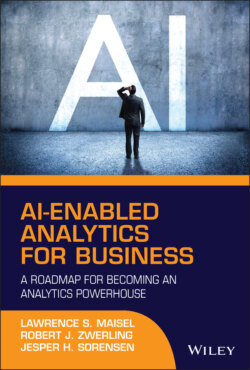Читать книгу AI-Enabled Analytics for Business - Lawrence S. Maisel - Страница 12
ANALYTICS VS. ANALYSIS
ОглавлениеAnother set of terms to get our arms around is analysis and analytics. Analysis, in business reporting, involves calculations of arithmetic (add, subtract, multiply, and divide), whereas analytics for business encompasses mathematics (algebra, trigonometry, geometry, calculus, etc.) and statistics (about the study of outcomes).
In a profit and loss statement, there is a variance analysis of current year actual performance against budget. The analysis is expressed as the difference in dollars and as a percent. The variance analysis uses arithmetic to make a measurement of the existing condition of the company compared to what it planned for the year. This analysis is comparative information from arithmetic on data and descriptive of a current situation, but it is not an insight that is additive to a decision.
Insight, as defined with respect to the value from data, is that not known about the business and when known should affect decisions, and insights are derived from analytics that applies mathematics to data.
For example, say sales are down 15% for the past three months, but sales are predicted to increase this month. This prediction is based on a correlation of unemployment as a three-month inverse leading indicator to sales, meaning as unemployment goes down, sales will go up. In this example, unemployment has been dropping for the past three months, so the prediction is for sales to increase in the current month.
The use of correlations to make a prediction is analytics that reveals an insight, which was not known from the data or information from the analysis of the data, and which when known will affect decisions. In this case, without knowing the prediction of the lead indicator, the business would run deep discounts to attract sales. However, knowing that sales are predicted to reverse direction would cause the business not to discount or to only offer small discounts.
As such, to crystalize and distinguish the important definitions of insights and information, we repeat that insights are derived from the application of mathematics on data, while information is derived from the application of arithmetic on data. Information is used to support a decision, whereas insights are used to affect a decision.
Accordingly, analytics can powerfully reveal unbiased insights, as it applies mathematics on data that is void of the personal and political pressures that are exerted on humans when they make forecasts and predictions. As humans, we want the future to be what we desire or what we need, so we can make any forecast come to our desired outcome. As such, analytics is especially potent to enable unbiased data-driven decisions.
